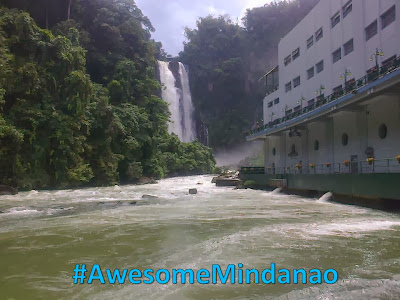MSU-IIT hosts a forum on Mainstreaming Flood Disaster Preparedness
Iligan City – The MSU-IIT Sustainable
Development Studies Program of the School of Graduate Studies and the Office of
the Vice Chancellor for Research and Extension partnered with ECOWEB and CAFOD
in hosting a forum on Mainstreaming Flood Disaster Preparedness on Friday,
January 13, 2012. Mainstreaming basically means an approach in responding to a
hazard which necessitates massive information drive to make all stakeholders be
informed about the impact of the calamities, their responsibilities in reducing
risk and their roles in the implementation of the action plan. Representatives
from civil society organizations, government entities and private sectors
joined the affair.
The first resource person Dir. Malu Fellizar - Cagay of the Center for
Disaster Preparedness (CDP) shared The PHILIPPINE DISASTER RISK REDUCTION
AND MANAGEMENT (DRRM) Act of 2010 which is REPUBLIC ACT NO. 10121. It’s an “An Act Strengthening the
Philippine Disaster Risk Reduction and Management System, Providing for the
National Disaster Risk Reduction and Management Framework and
Institutionalizing the National Disaster Risk Reduction and Management Plan,
Appropriating Funds Therefore and for Other Purposes” This law
highlights disaster prevention and risk reduction rather than emergency relief
and response. She explained 5 priorities for action for disaster risk reduction,
namely: Vulnerability Reduction, Risk Assessment, Governance, Knowledge Management
and Disaster Preparedness. Vulnerability refers to people’s exposure to risk
due to one major reason: the geographical location. Philippines for instance is
located in the western
segment of the Pacific Ring of Fire, the most active part of the earth, were
the active volcanoes and earthquake generators are found. Also, Philippines is
located in the Pacific typhoon belt. Hence, the country experiences an average
of 20 earthquakes a day and an average of 20 typhoons a year, 5 of which are
said to be destructive. Those living along the river banks, seashore and
landslide prone areas need to transfer to other locations to reduce
vulnerability. She also emphasized the role of the government specially the
Local Government Officials to have political will in implementing the law. It’s
a matter of consistently and diligently pushing forward the advocacy to make
things work. Risk assessment delves on the evaluation of the level of existing risk
and potential hazards that may cause harm to human beings, environment and
properties. This leads to tailored-suit planning and forecasting for risk
preparedness.
Dir. Regina Antequisa of the Ecosystems
Work for Essential Benefits, Inc. (ECOWEB) facilitated a participative identification on the
vulnerabilities to disaster risks and the local capacities to respond to the
identified hazards. The participants wrote their answers through meta cards and
were placed on the board. Several hazards were pointed out including
flashfloods, landslide and storm. On the socio-economic aspect, poverty tops
the list. This includes poor design of houses and its location in
disaster-prone areas. Lack of early warning signs, lack of expertise and
disaster unpreparedness were also brought out. Then the local capacities were
assessed to include the budget, equipment and infrastructures, a number of
volunteers and cooperation from all sectors of government and non-government
organizations. It is in the hope that the capacities will be maximized to
respond to the existing predicament and future calamities.
Dr. Rex Victor O. Cruz, Chancellor of the University of the Philippines
Los BaÑos was the second resource person who talked about the practical
guidelines for Integrating Adaptation and Disaster Risk Reduction in the
Comprehensive Land Use Plan. He shared the predisposing factors to flooding
like rugged topography, steep terrain, narrow valleys and plains, erodible soil,
poor vegetation cover and reduced infiltration. If there will be an excessive
rainfall, erodible soil is prone to landslide because of its composition. In
the recent Sendong typhoon, the heavy rainfall has caused the narrow valleys of
Barangay Rogongon become widened from 1 meter to 16 meters wide. Some portions
of the forest eroded which brought muddy water to the lowland areas. He also pointed out aggravating factors such
as the rising sea level in which waterflow heading towards it will be blocked. Participants
confirmed that it was high tide during the onslaught of the Sendong Typhoon.
Moreover, Dr. Cruz elaborated ways to respond to floods like sustained public
education and information about flood risks and the proper response to risk.
This is very important so that everyone will be vigilant should there be signs
of calamities. “Effective communication is seeing people take appropriate
action, he shared.” Improved management of forests was also discussed which
should be a multi-stakeholder driven approach for better results.
The third resource person was Dr. Nathaniel C. Bantayan, Head of the UPLB
Geographic Information System and Environmental Modeling Specialist. His
topic focused on Estimating the Impact of Natural Hazards Using GIS &
Remote Sensing. He shared the importance of geographic information system as a
basis for evaluating the impact of the hazards. The updated information will be
valuable to researchers and decision makers on what will be done should
calamities strike and to what extent is the damage that needs timely response.
He also talked about remote sensing. The energy coming from the sun will be
absorbed by the earth’s surface, the reflection of which will be analyzed in a
satellite sensor. This will serve as the source of data for receiving stations
subject to relevant interpretation of experts for users’ appreciation.
Inquisitive participants heighten up the informative
nature of the forum. One lady challenged everyone to implement everything in
CLUP because it seemed that “it is just on the table.” She further suggested
that it’s about time to localize the plan by applying it in the community level
where constituents are made informed of their roles and are encouraged to take
part in the clarion call for risk prevention and disaster preparedness. Another
person voiced out that activities such as the forum should not just be for
compliance, but more of an advocacy that everyone should be involved with.
Dr. Alita Roxas, Dean of the School of Graduate
Studies expressed her gratitude to everyone who took part in the said forum. It
is indeed a jumpstart for an action planning for disaster risk reduction and
management in the city. “The flashflood in Iligan way back 2007 ignited a call
for preparedness but when streets were cleaned and houses restored, plans were
forgotten,” she remembered. Hence, she encouraged everyone to join hands in
responding to the situation as well as in facing future disasters.
Meanwhile, Dr. Sukarno Tanggol, Chancellor of
MSU-IIT commended the organizers of the forum for it is indeed timely
considering the devastating effects of the flashfloods caused by Sendong typhoon. On this note, he said
that we need an accurate forecast and complete scientific data to be better
prepared. He further emphasized that disaster preparedness needs much
collaboration from all levels of the society including the community whose
constituents will be greatly affected when calamity occurs. A
multi-disciplinary approach is indeed important. Good governance, he recalled
from his learning in Public Administration courses, necessitates partnership -
a collaboration between and among government and non-government sectors.


Will there be another?
ReplyDeleteThere will be a massive public education about the outcome of the forum. Action planning was done after the affair. I am hopeful that the city government makes disaster risk reduction and management a priority. :-)
ReplyDelete